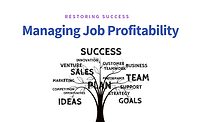Managing Restoration Job Profitability Part 2: The Budget
Restoring Success

courtneyk / E+ via Getty Images
Production Manager: “If you spend more than you got, you are not going to have a good time.”
There it is! Sounds simple, yet it happens every day. Production manager said specifically “not going to have a good time.” The financial result of our jobs is the revenue stream supporting the business operation. We are doing rewarding and meaningful work, but when we fail at managing our jobs to profitability, it is not fun, it is not good, and it puts the business in jeopardy.
In the 2018 Restoring Success, Managing Job Profitability, you will find a list of a variety of considerations in managing the profitability of a job with a couple of brief notes about the budget:
- “Budget based on a scope: If a scope of work is properly done before the work is executed, that should be representative of a job budget that is readily available to those responsible for the profitable execution of the job.
- Benchmarks: In the world of emergency services, we often deploy and then prepare the corresponding revenue. Your company can establish benchmarks based on experience and review of profitable jobs. Example: A water loss of $XXX = 20 Hours”
By definition, a budget is the income and planned expenses of a project. How much are we going to receive, spend, and profit (gross profit)? Consider it a profit plan. If the profit plan goes off track, you have two choices to hit your target:
- Increase the revenue.
- Decrease the expense.
In the following simple example, please note there are many ways to approach a budget.
| Description | Revenue | Budgeted Margin | Budget | Target Gross Profit |
|---|---|---|---|---|
| Door | $1000 | 20% | $800 | $200 |
| Carpet | $2000 | 10% | $1800 | $200 |
We analyze job outcomes and find:
| Description | Revenue | Budgeted Margin | Budget | Target Gross Profit | Paid | Gross Profit |
|---|---|---|---|---|---|---|
| Door | $1000 | 20% | $800 | $200 | $1027 | -$27 |
| Carpet | $2000 | 10% | $1800 | $200 | $2234 | -$234 |
Solutions
The solutions to this problem that is a plague in our industry relates to a variety of complexities. We can make an expansive list: price fluctuations, scheduling pressures, scope changes, workloads, pressures, and more. There is no alternative but to buckle down and fix it.
Based on reviewing job outcomes for over 20 years, I have observed a few issues that can be addressed by using a job budget. I call them the “Golden Rules.” Click the image below to download Job Golden Rules. You can use for training and job reviews.

Golden Rules:
- Get paid for what you do. A few tips:
- Minimize Emotional Discounting
- Manage and Eliminate Scope Creep
- Do not pay more than you get paid.
- Materials
- Trades/Subcontractors
- Anything
- Proactively Manage In-House Man Hours to a Budget
Find the Root Causes and figure out what you Need to Do. As you evaluate what your organization needs to better manage job profitability and employ the use of budgeting, consider the following based on the following approach: Download Needs Analysis
-
Operations: Do we have best practices? These are clearly defined expectations, assignment of responsibility, accountability, and workflows that support the execution of budgeting. As you analyze the operational needs, you may find it helpful to evaluate other related processes such as: the selections process, upgrades, and supplements.
An example of a best practice may look like:
< Insert Position > has < X days > from job assignment to establish a job budget and record in job file.
< Insert Position > has < X days > from time submitted to review and approve budget and record approval in job file.
An example of a workflow may look like:
As the job progresses, purchase orders, must be verified and approved based on the established job budget on file. Define who owns this responsibility(s). Those responsible who do not follow the plan should be held accountable. If the needed purchase does not fit the approved budget, define your company’s next steps: change orders, supplements, other.
-
Tools | Equipment | Supplies: You may identify the need to evaluate software, systems, templates, and budgeting forms. There are many tools that can help support the establishing and maintaining of the budget.
-
Skills: As you evaluate the skills and abilities, you may identify a mismatch of those who are assigned the budget responsibilities, or you may identify a need to develop your team. As I am currently going through a program to receive a certification in what is referred to as a High Performance Learning Journey. A High Performance Learning Journey is in reference to the expertise, research, and methodology developed by Professor Robert Brinkerhoff, is an engineered process, a journey, and by design is built around performance outcomes and business rationale.
The reasons we consider a High Performance Learning Journey for managing a budget are:
- The risk to the business is high.
- The skills and abilities are complex, intertwined, involve many other people. A few training considerations:
- Negotiation Skills
- Financial
- Critical Thinking
- Communications
- Ability to use company software and systems.
- More, more, more
Some quick tips to employ a High Performance Learning Journey in your organization, you can start by breaking down the performance objectives. Create a journey that includes training, practice, mentoring, and feedback. (This is a very compressed version to get to help create action.)
When job budgets go off track, it is easy to get frustrated by the outcomes that at the surface seem easy to control. Our operations are complex and there are many challenges and strains in the day to day. Regardless, if you identify the issue, there is opportunity in the challenge, but it requires action. Using budgets can help you improve the profitability of the jobs. If this seems daunting, consider the resources and consultants in our industry that can help you make a meaningful change and impact in this area. May budgets bring you much Restoring Success.
Looking for a reprint of this article?
From high-res PDFs to custom plaques, order your copy today!






